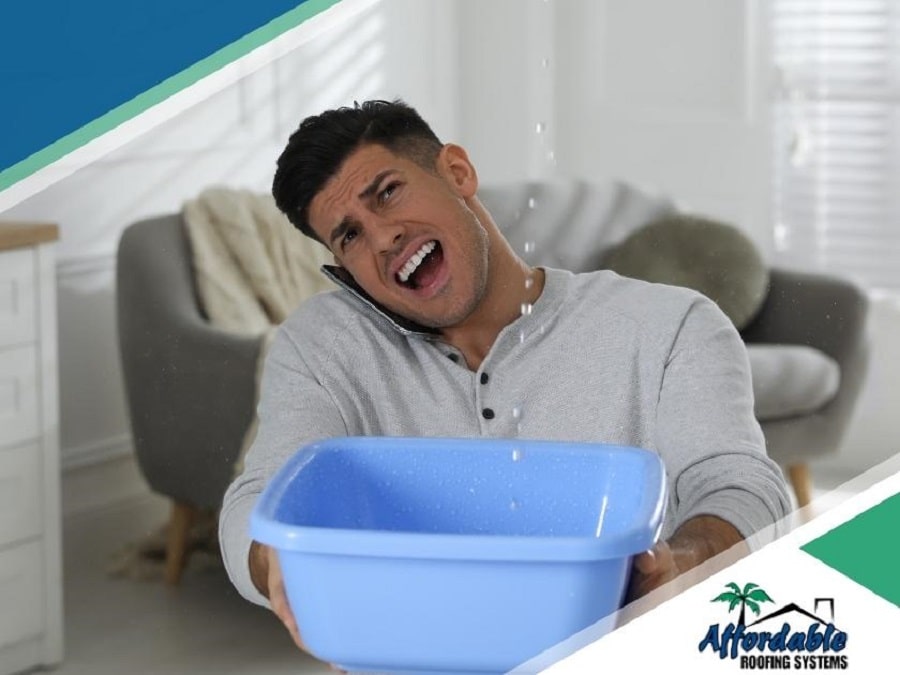Roof Leak Detection in Tampa: How to Spot & Prevent Water Damage
Protect your home before Tampa storms hit! Learn how to spot roof leaks early and get a FREE inspection from Affordable...

Tampa’s rainy climate can wear down even the best roofs, leading to costly leaks if left unchecked. Affordable Roofing Systems offers free inspections to catch issues early and keep your roof in top shape. If leaks are found, our Tampa Roof Repair services provide fast, reliable solutions to protect your home.
In this guide, we'll share expert tips to spot roof leaks before they become major problems.
Key Takeaways
- Check your attic for water stains or damp insulation, especially after storms.
- Look for missing or curling shingles—Affordable Roofing Systems uses durable architectural shingles.
- Keep gutters clear to prevent water buildup and leaks.
- Get a free inspection to catch issues early and avoid costly roof repairs.
Common Roof Leak Causes in Tampa
In Tampa, roof leaks stem from a combination of extreme weather conditions and normal wear and tear. Common causes include damaged or missing roof tiles or shingles, worn-out flashing around chimneys, skylights, or vents, and clogged gutters that prevent proper water drainage. Flat and metal roofing can develop leaks from poor installation or aging materials, while asphalt shingles may degrade due to extended exposure to heat and moisture.
By scheduling regular inspections and addressing roof repair issues promptly, you can prevent these common problems from leading to costly water damage.
Signs of Water Damage in Tampa Homes
Catching water damage early can save you from costly repairs and protect the structural integrity of your home. In Tampa's rainy climate, water intrusion is common, but recognizing the signs early helps you address problems before they escalate.
Ceiling Stains and Water Intrusion
- Dark spots on your ceilings or walls may indicate a hidden roof leak.
- If left untreated, stains can spread, worsen, and lead to mold growth.
- Action: Inspect your roof for missing shingles, flashing damage, or cracks before leaks escalate.
Mold Growth From Roof Leaks
Mold thrives in damp conditions and environments with high humidity, such as Tampa. If you spot mold growth on your walls, ceilings, or even carpets, it could be a sign of persistent moisture from a leaking roof. Not only does mold cause health hazards, but it also weakens the structural integrity of your home.
Damp Walls and Hidden Moisture
Damp walls or hidden moisture behind drywall can indicate water intrusion from a roof leak. This issue often goes unnoticed until it causes more severe damage like rotting wood or weakened insulation. Regularly checking your walls for signs of moisture, such as peeling paint or soft spots, can help you catch water damage early.
For more detailed information, check out our comprehensive guide on mold and mildew risks from roof damage.

Inspecting Your Attic for Roof Leaks in Tampa
Regular attic inspections help you catch roof leaks early and prevent costly damage. In Tampa’s climate, staying proactive is key to maintaining your home’s integrity. Here’s how to effectively inspect your attic:
- Check for Water Stains: Water stains on rafters, insulation, or ceiling panels are a clear sign that water has infiltrated your roof. By identifying these stains early, you can prevent further damage, like rotting wood or mold growth, which can jeopardize the structural integrity of your home. However, if you don’t find a leak, these water stains may be caused by condensation from poor ventilation or even a plumbing leak.
- Assess Insulation: Damp or compressed insulation is a major red flag. Wet insulation loses its ability to regulate temperature, which can lead to higher energy bills.
- Look for Pests: Pests like rodents and insects can create entry points for water, leading to leaks and further damage. They can also compromise your insulation and disrupt ventilation, making it harder to maintain a healthy attic environment.
Checking Roof Flashing for Leaks
Roof flashing is a critical barrier against leaks, protecting seams and joints around chimneys, skylights, vents, and roof valleys—areas most vulnerable to water intrusion. To prevent leaks, regularly inspect your flashing for:
- Cracks, rust, or corrosion that weaken its ability to repel water.
- Loose or missing flashing that can expose your roof to moisture.
- Signs of water damage near flashing points, such as stains or mold.
How to Keep Flashing Leak-Free in Tampa’s Climate
Since Tampa’s humidity and storms accelerate wear, follow these maintenance tips:
- Choose the Right Materials – Use aluminum, copper, or galvanized steel, which resist rust and corrosion.
- Ensure Proper Installation – Flashing should be securely attached and overlapping correctly to prevent gaps.
- Inspect & Maintain Regularly – Check flashing twice a year and after major storms to catch early signs of damage.
When to Replace Roof Flashing
If you notice cracks, missing sections, or rust, it’s time for repairs. Damaged flashing allows leaks to spread into walls and even your home’s foundation, leading to costly structural issues.
Evaluating Gutters and Downspouts for Leak Prevention in Tampa
Gutters and downspouts play an essential role in directing water away from your roof and foundation, preventing potential leaks and structural damage.
Regularly evaluating their condition is vital, especially in Tampa's rainy climate. Here's what you should focus on:
- Gutter Cleaning: Confirm your gutters are free from debris like leaves and twigs. Blocked gutters can cause water to overflow, leading to leaks and erosion.
- Downspout Maintenance: Inspect downspouts for clogs and confirm water flows freely. If the downspout is blocked, water can back up into the gutters, increasing the risk of leaks.
- Secure Connections: Check the joints where gutters meet downspouts. Loose or damaged connections can allow water to escape, creating potential leak sites.
Monitoring Interior Walls for Roof Leaks in Tampa
After checking your gutters and downspouts, inspect your interior walls for signs of hidden roof leaks, which can cause structural damage over time.
Key Indicators of Roof Leaks Inside Your Home:
| Indicator | What to Look For | Action Required |
| Water Stains | Brown or yellow spots on walls/ceilings | Investigate source, repair leak |
| Peeling Paint | Bubbling or flaking | Remove damaged paint, check for leaks |
| Warped Drywall | Soft spots, uneven texture | Replace affected sections, check roof |
| Damp Insulation | Wet or compressed insulation in walls | Address leak, replace insulation |
Pro Tip: If left unchecked, leaks can lead to mold growth. You may be dealing with mold or mildew buildup if you notice dark patches, musty odors, or allergy symptoms.
Recognizing Mold and Mildew as Leak Indicators in Tampa
Mold and mildew thrive in damp conditions, making Florida's humid weather ideal for their growth. If a leak goes undetected, mold can develop, posing both structural and health risks.
Signs of Mold & Mildew Growth from Roof Leaks:
- Discoloration: Dark or yellow stains on ceilings and walls may indicate long-term moisture exposure.
- Musty Odor: A persistent damp, musty smell is often a sign of hidden mold inside walls.
- Health Symptoms: Mold exposure can cause allergies, coughing, and respiratory issues.
Action Step: If you notice mold, schedule a roof inspection to find and eliminate the leak before it worsens.

The Importance of Regular Roof Inspections in Tampa
Your roof is your home’s first line of defense against Tampa’s extreme weather, including severe storms, wind, hail, and even occasional ice dams or snow events. Over time, wear and tear from ultraviolet rays, humidity, and debris buildup can weaken its waterproofing, leading to leaks, water damage, and costly repairs.
Regular roof inspections, ideally every 6 to 12 months, can help identify early signs of deterioration and prevent roof repairs that compromise your home insurance coverage. In some cases, a roofing contractor can find hidden leaks using infrared cameras to detect moisture infiltration before it damages wood framing, drywall, and insulation.
Benefits of Routine Roof Inspections:
- Prevent leaks in skylights, chimneys, flashing, and attic spaces before they worsen.
- Extend your roof’s longevity by addressing rust, corrosion, and loose tiles before they fail.
- Ensure warranty compliance — many home insurance companies require regular roof maintenance to uphold coverage.
- Improve home energy efficiency — damaged roofs with gaps, missing caulk, or poor ventilation can raise your electricity bill due to heat loss.
How Often Should You Schedule a Roof Inspection?
| Inspection Frequency | Recommended Actions |
| Biannual (Every 6 Months) | Check for leaks, mold, mildew, flashing wear, and clogged gutters. |
| After Major Storms or Hail | Look for loose shingles, tile cracks, missing screws, and water stains on ceilings and drywall. |
| Pre-Rainy Season | Assess skylights, soffits, mortar joints, and attic ventilation for potential leaks. |
| Post-Rainy Season | Check for roof deck swelling, rusted nails, and water infiltration around framing and chimneys. |
Severe weather can cause unexpected damage—even to metal roofs and flat roofs, which are designed for durability. If you see signs of leaks, rust, or pest damage, don’t wait—schedule an inspection immediately!
Pro Tip: Tampa storms can cause hidden damage. Schedule a free roof inspection before the next one hits!
Preventive Maintenance Tips for Tampa Roof Leak Prevention
Regular roof maintenance helps prevent roof leaks before they start. A professional roofing contractor will perform leak detection using infrared, bitumen testing, and adhesion analysis to check for weak spots.
Here’s what you can do between inspections to protect your roof and home:
- Check for Early Warning Signs – Inspect your attic, drywall, ceilings, and siding for stains, odor, or mold—signs of a hidden roof leak.
- Clear Debris Regularly – Remove leaves, twigs, and tree branches to prevent clogged gutters and water damage.
- Apply Roof Sealant & Waterproofing – Roof repairs should include quality caulk and mortar sealing to prevent moisture penetration.
- Monitor Flashing, Vents, and Boots – Damaged flashing, soffits, or chimney caps can allow rainwater infiltration, leading to rot and foundation issues.
Pro Tip: Regular roof maintenance can save you thousands in emergency Tampa Roof Repair!
Protect Your Tampa Home from Roof Leaks
Roof leaks can lead to costly repairs, mold growth, and structural damage. By inspecting your attic, checking flashing, and maintaining gutters, you can protect your home from Tampa’s heavy rains.
Concerned about potential roof leaks? Affordable Roofing Systems offers free roof inspections for Tampa roof leak detection and expert repair services tailored to Tampa’s unique climate. Call (813) 542-8462 or visit our Tampa Roof Repair website today to get started with a FREE estimate!
